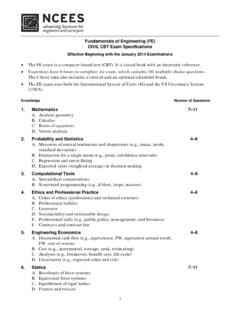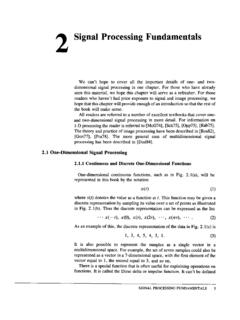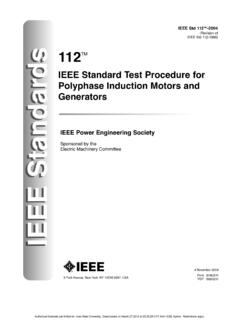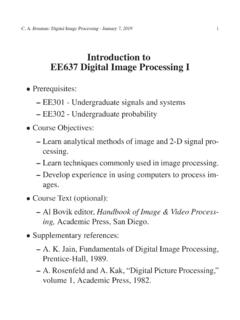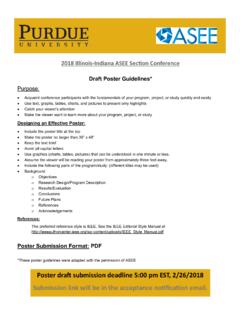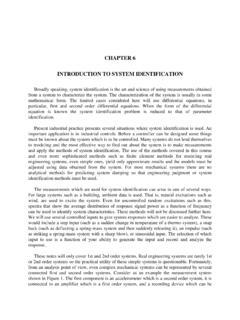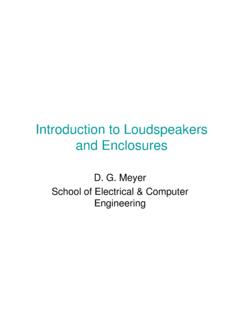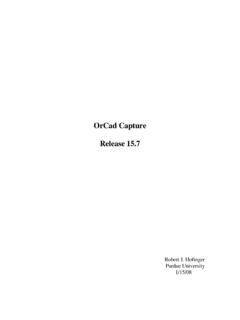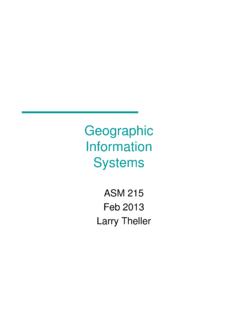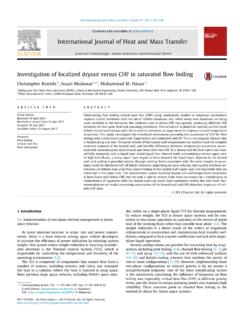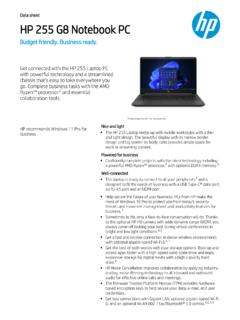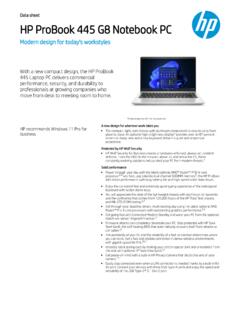Transcription of ECE 380: Control Systems - Purdue University College of ...
1 ECE 380: Control SystemsCourse Notes: Winter 2014 Prof. Shreyas SundaramDepartment of Electrical and Computer EngineeringUniversity of Waterlooiic Shreyas SundaramAcknowledgmentsParts of these course notes are loosely based on lecture notes by ProfessorsDaniel Liberzon, Sean Meyn, and Mark Spong ( University of Illinois), on notesby Professors Daniel Davison and Daniel Miller ( University of Waterloo), andon parts of the textbookFeedback Control of Dynamic Systems (5th edition) byFranklin, Powell and Emami-Naeini. I claim credit for all typos and mistakesin the LATEX template forThe Not So Short Introduction to LATEX 2 by T. Oetikeret al. was used to typeset portions of these SundaramUniversity of Waterlooc Shreyas Sundaramivc Shreyas SundaramContents1 Dynamical Systems .. What is Control Theory? .. Outline of the Course ..42 Review of Complex Numbers53 Review of Laplace The Laplace Transform.
2 The Inverse Laplace Transform .. Fraction Expansion .. The Final Value Theorem .. 154 Linear Time-Invariant Linearity, Time-Invariance and Causality .. Transfer Functions .. the transfer function of a differential equationmodel .. Frequency Response .. 215 Bode Rules for Drawing Bode Plots .. Plot forKo.. Plot forsq.. Plot for (sp+ 1) 1and (sz+ 1) .. 29c Shreyas Plot for((s n)2+ 2 (s n) + 1) 1.. Phase Systems .. 346 Modeling and Block Diagram Mathematical Models of Physical Systems .. Systems .. Systems .. Systems .. Block Diagram Manipulation .. with Multiple Inputs and Outputs .. 457 Step Responses of Linear Step Response of First Order Systems .. time .. time .. Step Response of Second Order Systems .
3 And Critically Damped Systems (0 1) System ( >1) .. 528 Performance of Second Order Step Performance Measures .. time (tr) .. value (Mp), Peak time (tp) and OvershootOS.. Time (ts) .. Choosing Pole Locations to Meet Performance Specifications .. Effects of Poles and Zeros on the Step Response .. of a Zero on the Step Response .. of Poles on the Step Response .. 639 Stability of Linear Time-Invariant Pole-zero cancellations and stability .. Stability of the Unity Feedback Loop .. Tests for Stability .. 68c Shreyas Necessary Condition for Stability .. Necessary and Sufficient Condition: Routh-Hurwitz Test For Degree of Stability .. Parametric Stability with Routh-Hurwitz .. 7310 Properties of Feedforward Control .. Feedback Control .
4 7711 Tracking of Reference Tracking and Steady State Error .. 8212 PID Proportional (P) Control .. Proportional-Integral (PI) Control .. Proportional-Integral-Derivative (PID) Control .. Implementation Issues .. 9313 Root The Root Locus Equations .. Phase Condition .. Rules for Plotting the Positive Root Locus .. Start Points and (Some) End Points of the Root Locus . Points on the Real Axis .. Asymptotic Behavior of the Root Locus .. Breakaway Points .. Some Root Locus Plots .. Choosing the Gain from the Root Locus .. Rules for Plotting the Negative Root Locus .. 11114 Stability Margins from Bode Plots11515 Compensator Design Using Bode Lead and Lag Compensators .. Lead Compensator Design .. Lag Compensator Design .. 130c Shreyas SundaramviiiCONTENTS16 Nyquist Nyquist Plots.
5 Drawing Nyquist Plots .. Nyquist Plots For Systems With Poles/Zeros On The Imag-inary Axis .. Stability Margins from Nyquist Plots .. 14617 Modern Control Theory: State Space State-Space Models .. Nonlinear State-Space Models and Linearization .. Linearization via Taylor Series .. The Transfer Function of a Linear State-Space Model .. Obtaining the Poles from the State-Space Model .. An Overview of Design Approaches for State-Space Models .. 162c Shreyas SundaramChapter Dynamical SystemsFor the purposes of this course, asystemis an abstract object that acceptsinputsand producesoutputsin response. Systems are often composed of smaller com-ponents that are interconnected together, leading to behavior that is more thanjust the sum of its parts. In the Control literature, Systems are also commonlyreferred to : An abstract representation of a termdynamical systemloosely refers to any system that has an internalstate and some dynamics ( , a rule specifying how the state evolves in time).
6 This description applies to a very large class of Systems , from automobiles andaviation to industrial manufacturing plants and the electrical power grid. Thepresence of dynamics implies that the behavior of the system cannot be en-tirely arbitrary; the temporal behavior of the system s state and outputs can bepredicted to some extent by an appropriatemodelof the a simple model of a car in motion. Let the speed ofthe car at any timetbe given byv(t). One of the inputs to the system is theaccelerationa(t), applied by the throttle. From basic physics, the evolution ofthe speed is given bydvdt=a(t).( )The quantityv(t) is the state of the system, and equation ( ) specifies thedynamics. There is a speedometer on the car, which is a sensor that measuresc Shreyas Sundaram2 Introductionthe speed. The value provided by the sensor is denoted bys(t) =v(t), and thisis taken to be the output of the shown by the above example, the inputs to physical Systems are applied viaactuators, and the outputs are measurements of the system state provided examples of Systems :Electronic circuits, DC Motor, Economic Sys-tems.
7 What is Control Theory?The field ofcontrol systemsdeals with applying or choosing the inputs to agiven system to make it behave in a certain way ( , make the state or outputof the system follow a certain trajectory). A key way to achieve this is via theuse offeedback, where the input depends on the output in some way. This isalso calledclosed loop fromoutput to inputInputFigure : Feedback , the mapping from outputs to inputs in the feedback loop is performedvia a computational element known as acontroller, which processes the sensormeasurements and converts it to an appropriate actuator signal. The basicarchitecture is shown below. Note that the feedback loop typically containsdisturbancesthat we cannot Figure : Block Diagram of a feedback Control 2(Cruise Control ).Consider again the simple model of a car fromExample 1.
8 Acruise Control systemfor the car would work as Shreyas What is Control Theory?3 The speedometer in the car measures the current speed and producess(t) =v(t). The controller in the car uses these measurements to produce Control sig-nals: if the current measurements(t) is less than the desired cruisingspeed, the controller sends a signal to the throttle to accelerate, and ifs(t) is greater than the desired speed, the throttle is asked to allow thecar to slow down. The throttle performs the action specified by the motion of the car might also be affected by disturbances such as windgusts, or slippery road conditions. A properly designed cruise Control systemwill maintain the speed at (or near) the desired value despite these 3(Inverted Pendulum).Suppose we try to balance a stick verticallyin the palm of our hand.
9 The sensor , controller and actuator in this exampleare our eyes, our brain, and our hand, respectively. This is an example of afeedback Control system. Now what happens if we try to balance the stickwith our eyes closed? The stick inevitably falls. This illustrates another typeof Control , known asfeedforwardoropen loopcontrol, where the input to thesystem does not depend on the output. As this example illustrates, feedforwardcontrol is notrobustto disturbances if the stick is not perfectly balanced tostart, or if our hand moves very slightly, the stick will fall. This illustrates thebenefit of feedback we will see later, feedback Control has many strengths, and is used to achievethe following objectives. Good tracking. Loosely speaking, feedback Control allows us to makethe output of the system follow the desired reference input ( , make thesystem behave as it should).
10 Disturbance rejection. Feedback Control allows the system to maintaingood behavior even when there are external inputs that we cannot Control . Robustness. Feedback Control can work well even when the actual modelof the plant is not known precisely; sufficiently small errors in modelingcan be counteracted by the feedback Control is everywhere; it appears not only in engineered Systems (suchas automobiles and aircraft), but also in economic Systems ( , choosing theinterest rates to maintain a desired rate of inflation, growth, etc.), ecological sys-tems (predator/prey populations, global climate) and biological Systems ( ,physiology in animals and plants).c Shreyas Sundaram4 IntroductionExample 4(Teary Eyes on a Cold Day).Blinking and tears are a feedbackmechanism used by the body to warm the surface of the eyeball on cold days the insides of the lids warm the eyes.
